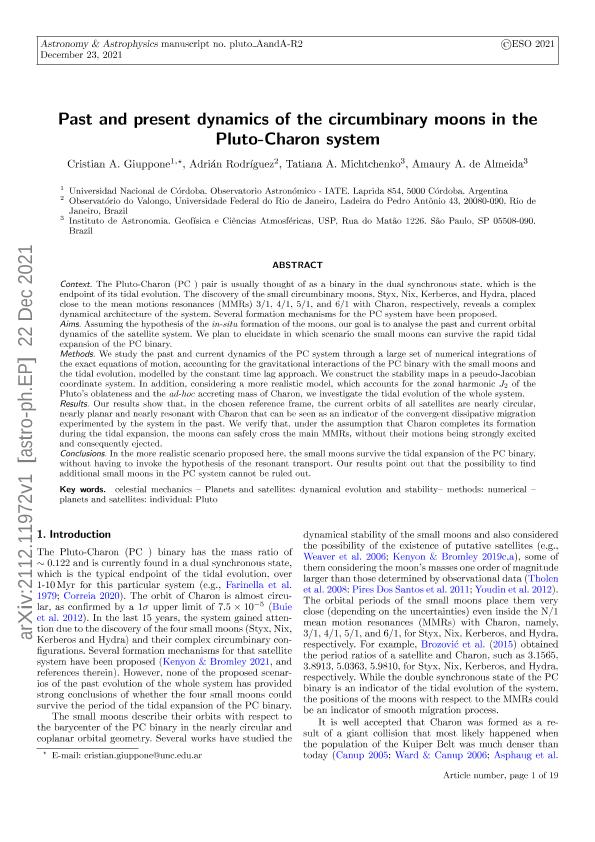Artículo
Past and present dynamics of the circumbinary moons in the Pluto-Charon system
Fecha de publicación:
02/2022
Editorial:
EDP Sciences
Revista:
Astronomy and Astrophysics
ISSN:
0004-6361
Idioma:
Inglés
Tipo de recurso:
Artículo publicado
Clasificación temática:
Resumen
Context. The Pluto-Charon (PC) pair is usually thought of as a binary in a dual synchronous state, which is the endpoint of its tidal evolution. The discovery of the small circumbinary moons, Styx, Nix, Kerberos, and Hydra, placed close to the mean motion resonances (MMRs) 3/1, 4/1, 5/1, and 6/1 with Charon, respectively, reveals a complex dynamical system architecture. Several formation mechanisms for the PC system have been proposed. Aims. Assuming the hypothesis of an in situ formation of the moons, our goal is to analyse the past and current orbital dynamics of the satellite system. We plan to elucidate on in which scenario the small moons can survive a rapid tidal expansion of the PC binary. Methods. We study the past and current dynamics of the PC system through a large set of numerical integrations of the exact equations of motion, accounting for the gravitational interactions of the PC binary with the small moons and the tidal evolution, modelled by the constant time lag approach. We construct stability maps in a pseudo-Jacobian coordinate system. In addition, considering a more realistic model that accounts for the zonal harmonic, J2, of Pluto's oblateness and the ad hoc accreting mass of Charon, we investigate the tidal evolution of the whole system. Results. Our results show that, in the chosen reference frame, the current orbits of all satellites are nearly circular, nearly planar, and nearly resonant with Charon, which can be seen as an indicator of the convergent dissipative migration experienced by the system in the past. We verify that, under the assumption that Charon completes its formation during the tidal expansion, the moons can safely cross the main MMRs without their motions being strongly excited and consequently ejected. Conclusions. In the more realistic scenario proposed here, the small moons survive the tidal expansion of the PC binary without the hypothesis of resonant transport having to be invoked. Our results indicate that the possibility of finding additional small moons in the PC system cannot be ruled out.
Archivos asociados
Licencia
Identificadores
Colecciones
Articulos(IATE)
Articulos de INST.DE ASTRONOMIA TEORICA Y EXPERIMENTAL
Articulos de INST.DE ASTRONOMIA TEORICA Y EXPERIMENTAL
Citación
Giuppone, Cristian Andrés; Rodríguez, Adrián; Michtchenko, Tatiana A.; De Almeida, Amaury A.; Past and present dynamics of the circumbinary moons in the Pluto-Charon system; EDP Sciences; Astronomy and Astrophysics; 658; A99; 2-2022; 1-19
Compartir
Altmétricas




